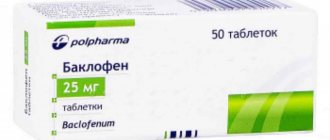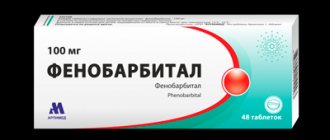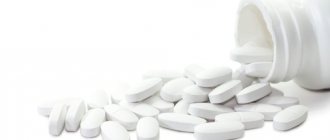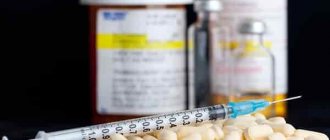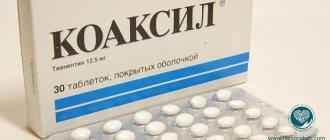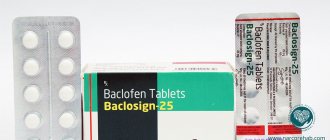Effects
Buprenorphine is widely used in foreign countries as an anesthetic in traumatology, surgery and in the palliative treatment of cancer patients.
It is also part of the complex treatment of drug withdrawal syndrome, including blocking the effect of heroin. Unlike methadone, in the United States a prescription for it can be issued by any doctor who has completed a full-time training course. After consumption, you may experience a headache and dry mouth. Sometimes patients complain of nausea and vomiting, sweating. In addition, the substance potentiates the effects of other psychotropic drugs and alcohol.
Buprenorphine – what is it?
Since its organic structure is similar to morphine, the drug effectively stimulates the nervous system, but is addictive and causes all the accompanying symptoms (aggression, sleep disorders, anxiety).
The drug was synthesized in the last century and was actively used by doctors to relieve withdrawal symptoms. After confirmation of the negative effect of a substance on the body, its medical use is under strict control. Pharmaceutical companies sell medicine under the names: Norphine, Bupranal, Buprenorphine - tablets and solution for injection. Drug addiction treatment
consultation with a narcologist at home and in hospital
relief from buprenorphine withdrawal
We work around the clock
Free consultation Leave a request and we will call you back in 1 minute
8
Or call
Consequences of use
Buprenorphine begins to act 10-30 minutes after administration and has an effect for the next 6-8 hours. The maximum daily dose is 1.8 mg or 6 ml of 0.03% solution. Selection of the dose and duration of the course is carried out individually.
One of the main advantages of this analgesic over others is its mild euphoric effect. Partial activation of different opioid receptors reduces toxicity. But use in overdoses is fraught not with a narcotic “high,” but with the risk of death due to depression of the respiratory center and, to a lesser extent, cardiovascular regulation.
Despite the less pronounced toxic properties, use can have characteristic consequences. First of all, complications are likely to develop at the injection sites: damage to the oral cavity, post-injection abscesses and phlebitis. In the long term, a person faces toxic hepatitis, a decrease in the body’s immunological resistance, heart failure and reversible disorders of the neuropsychiatric spectrum (tremor, irritability, weakness, fog).
Buprenorphine - effect of use
Dependence on buprenorphine can develop either after a therapeutic course prescribed by a doctor or after self-administration. The latter is often practiced by drug addicts, since the medicine can replace the effect of other drugs on brain receptors; after taking the drug, the person experiences a familiar feeling of euphoria. This is where buprenorphine works in a drug treatment program - replacing one drug with another. You can determine that a person is taking medication by the following external signs:
- decreased pain threshold;
- slow, incoherent speech;
- fear of sharp, loud sounds;
- respiratory disorders;
- decreased blood pressure;
- small pupils, pallor.
An analysis of the patient’s urine reliably confirms the fact of drug use, determining its type, since the above symptoms are characteristic of a number of drugs.
Formation of addiction
The drug is most often prescribed in standard doses in short courses, for example, in the postoperative period. With constant use for the relief of chronic pain syndrome, there is a low risk of addiction. But it occurs much less frequently than with morphine or heroin.
According to the UNODC, the development of euphoria with frequent administration of large doses of buprenorphine is a myth. Therefore, abuse for the purpose of drug addiction in this case is simply meaningless. In isolated cases, when it was discontinued, abstinence was observed, indicating the presence of addiction.
Buprenorphine - side effects
The effects of administration are observed within eight hours, and although the narcotic effect is weak, the analgesic effect is quite strong. When administered intravenously, the body reacts after 15 minutes, tablets and powders work more slowly. The medication may cause the following side effects:
- nausea;
- migraine;
- chills, tremors;
- hallucinations;
- illogical behavior;
- disorders of the vestibular apparatus;
- change in heart rate.
The combination of buprenorphine and alcohol has a detrimental effect on the human central nervous system. Exceeding the permissible dose of the drug can cause respiratory spasms and serious disturbances in the functioning of the heart, including cardiac arrest.
Narcotic analgesics are medications intended primarily for pain relief and treatment. The differences between opioids are due to the effects they have on the receptors. They are classified according to the following criteria: a) affinity for μ-, κ- or σ-receptors; b) degree of binding to the receptor (strength and duration of action); c) competitive ability to the receptor (agonists or antagonists). Particular importance is attached to agonists (morphine, fentanyl, etc.) of μ-receptors due to their strong analgesic effect, however, their activation gives rise to a number of side effects, including the most dangerous (depression of breathing and consciousness, impaired motility of the digestive tract, urinary and biliary tract). The use of morphine-like drugs is associated with dangerous complications, especially in frail and elderly patients [1]. κ-receptor agonists (pentazocine, etc.) are characterized by mild analgesia, increased sedation, and mild respiratory depression. The difference between κ-receptor agonists is their antagonism towards μ-receptors, therefore they are used as antagonists of morphine and its analogues [2].
Buprenorphine (B) has the properties of a partial agonist of μ-opiate receptors and an antagonist of κ-receptors; its effect on the human body can be characterized as a delayed interaction with receptors, manifested in high lipophilicity, a relative duration of action due to the absence of dysphoric reactions. Side effects include nausea, vomiting and severe respiratory depression. This analgesic is close to opiates in terms of cross-tolerance to them. In small doses (0.2-0.6 mg), B has a strong analgesic effect, 25-40 times greater than the effect of morphine, lasting up to 8 hours, but in terms of narcogenicity it is inferior to diacetylmorphine (heroin) and methadone; capable of forming physical dependence.
Abroad (USA, Germany, Holland, etc.), methadone and B are widely used in anti-withdrawal, so-called substitution, therapy for heroin addiction. The use of B in treatment regimens makes it possible to counteract drug trafficking, is economically beneficial and is not associated with intoxication [3]. In our opinion, the effectiveness of palliative therapy is not indisputable; it is not carried out in Russia.
The purpose of the work is to identify the features of a comprehensive study of B.
Buprenorphine (base) is a white or almost white crystalline powder, very poorly soluble in water, easily soluble in acetone, methanol and diethyl ether, slightly soluble in cyclohexane, soluble in dilute mineral acids. Hydrochloride B (salt) is a white or almost white crystalline powder, poorly soluble in water and ethanol, well in methanol, practically insoluble in cyclohexane and diethyl ether. In accordance with pharmacological requirements, a solution (10 mg/ml) of hydrochloride B in water should have a pH of 4.0-6.0. The acidity of the analgesic solution is tested as follows: to 10 ml of the drug solution (250 mg of the substance is dissolved in 5 ml of methanol, and then adjusted to a volume of 25 ml with carbon monoxide-free water) add 0.05 ml of methyl red solution, 0. 2 ml of 0.02 M sodium hydroxide solution or 0.02 M hydrochloric acid solution. The color of the solution should remain unchanged.
Ethanol solution B (base) at a concentration of 10 mg/ml rotates the plane of polarization of light by –103° – –107°, a methanol solution of its salt at a concentration of 20 mg/ml by –92° – –98°) [4].
B is obtained from the opium alkaloid thebaine by synthesis in several stages. The seven-step synthesis of B from thebaine, described in the literature [5], can be represented schematically (Fig. 1).
Rice. 1. Scheme for the synthesis of buprenorphine from thebaine.
Basic reagents
in synthesis: sodium, triethylamine, Rochelle salt (potassium sodium tartrate), hydrogen, magnesium, Raney nickel, cyanogen bromide, methyl vinyl ketone, tert-butyl chloride, cyclopropanecarboxylic acid chloride, sodium hydroxide, lithium aluminum hydride, ammonium chloride, etc. Main
solvents
: ethanol, benzene , dichloromethane, tetrahydrofuran, methanol, diethylene glycol, diethyl ether.
Intermediates
: tetrahydro-7α-acetyl-6,14-
endo
etenothebain;
tetrahydro-7α-(2-hydroxy-3,3-dimethylbut-2-yl)-6,14- endo
etenothebain;
tetrahydro-7α-(2-hydroxy-3,3-dimethylbut-2-yl)-6,14- endo
ethanotebaine;
N-cyano-tetrahydro-7α-(2-hydroxy-3,3-dimethylbut-2-yl)-6,14- endo
ethanotebaine;
tetrahydro-7α-(2-hydroxy-3,3-dimethylbut-2-yl)-6,14- endo
-ethanonorthebaine;
N-cyclopropylmethyltetrahydro-7α-(2-hydroxy-3,3-dimethylbut-2-yl)-6,14- endo
etenothebain. Traces of these compounds can play the role of evidence in identifying channels for the entry of B into illegal circulation (smuggling of medical drugs from abroad and theft from medical institutions).
Abroad, B is produced in the form of ampoule preparations of 1 and 2 ml containing 0.3 mg/ml buprenorphine hydrochloride, tablets containing 0.2, 2.0 or 8.0 mg of B (Subutex); various transdermal systems (Transtec) manufactured in Belgium, Great Britain, Germany and New Zealand. In 2002, it began producing tablets containing a mixture of B and naloxone at 2.0/0.5 and 8/2 mg, respectively; The drug was called Suboxone. In our country, B was purchased abroad, and its production has now been established. Cases of abuse of drugs containing and leading to intoxication have been described [6-8].
Biotransformation of B in the human body occurs in the liver and kidneys. It should be noted that metabolites B (norbuprenorphine, etc.) are excreted in the urine, and the native form is excreted in feces. Metabolism in the kidneys and liver occurs by N-dealkylation or by binding into conjugates. After oral administration, the analgesic undergoes a “first pass” effect through the liver, and its half-life (t½) in the initial phase is 1.2-7.2 hours, in the final phase 20-25 hours. In the case of intramuscular administration, Cmax in plasma is achieved in within a short time. After sublingual administration, it is absorbed buccally, and Cmax is reached after 90 minutes. Imported drugs (tablets) must not be chewed or swallowed, since the effect of action B is noticeably reduced due to the primary metabolism of the substance in the liver. Preparations B are prescribed to adults sublingually 1-2 tablets (0.2-0.4 mg) every 6-8 hours, and as injections 1-2 ml (0.3-0.6 mg) intramuscularly or intravenously (slowly). ) every 6-8 hours. The maximum daily dose is 6 ml (1.8 mg), some sources indicate a dose of 3-5 mg. There are cases of administration of drugs in the form of solutions under the skin in the same doses, epidural drip - 5-50 mcg/hour, and epidural bolus - 50-60 mcg (1 mcg/kg).
The turnover of B in Russia is limited (list II of the Decree of the Government of the Russian Federation No. 681 of June 30, 1998 “On approval of the List of narcotic drugs, psychotropic substances and their precursors subject to control in the Russian Federation”). Controlled isomers (including stereoisomers) B (21-cyclopropyl-7-α-[(S)-1-hydroxy-1,2,2-trimethylpropyl]-6,14- endo
ethano-6,7,8,14-tetrahydrooripavine), as well as its salts (buprenorphine hydrochloride).
The position of “buprenorphine” is ambiguous from a legal point of view, since it is an analgesic related to opiates, classified as a “hard drug” [9], it forms physical, moderate psychological dependence with moderate tolerance, and is therefore allowed for limited use in medicine. Currently, there is an increase in cases of seizure of B (Belarus, Armenia) [10], illegal production is rare, isolated cases are production “for one’s own needs” or “for experimental purposes.” The low number of crimes can be explained by the drug entering the criminal market from countries where the buprenorphine substitution program operates.
Pharmacopoeial analysis B is carried out in accordance with the articles of the European Pharmacopoeia [4], British Pharmacopoeia [11], US Pharmacopoeia [12], as well as the State Pharmacopoeia of Ukraine [13]. The main goal of pharmacoanalysis is to establish the authenticity of a drug. They examine not only the substance, but also the packaging details.
Substances are identified by IR spectrometry (pharmacopoeial requirements), the characteristic absorption bands are as follows: 3402, 3079, 2977, 2956, 2852, 2810, 1832, 1737, 1631, 1608, 1509, 1460, 1429, 1410, 1388, 13 71, 1331 , 1311, 1281, 1239, 1218, 1197, 1161, 1132, 1081, 1024, 997, 964, 947, 904, 886, 852, 824, 789, 746, 724, 700, 561, 522 and 43 2 cm–1 [ 14]. In accordance with the method of study B [15], 1 ml of n-hexane or n-pentane, alkalized with a drop of ammonia solution, is added to 1 mg of the drug powder or 1 ml of its solution in water. The resulting mixture is shaken vigorously, allowed to settle, and then a part of the upper layer (0.6-0.8 ml) is carefully removed with a pipette so as not to capture the lower aqueous layer. The selected sample is transferred to an agate mortar and the solvent is evaporated, after which it is additionally dried in an oven at a temperature of 60 °C for 15 minutes. The white residue formed on the walls of the mortar is ground with potassium bromide and pressed into a tablet, which is analyzed.
For hydrochloride B substances, the presence of chloride ion is determined: to 0.5 ml of a 50 mg/ml methanol solution of the substance, add 0.2 ml of a freshly prepared solution (1:10 by volume) of potassium ferricyanide and 0.2 ml of ferric chloride solution. In the presence of salt B, the formation of a blue color is observed.
High-performance liquid chromatography is used to determine the presence of intermediates and by-products of opioid synthesis. Chromatography conditions: metal column 250 mm long and 4.6 mm in diameter, filled with 5 µm ODS silica gel; isocratic operating mode, speed 1 ml/ml mobile phase, which is a mixture of a solution of 10 mg/ml ammonium acetate and methanol (10:60 by volume); detection at a wavelength of 288 nm; column temperature 40 °C; sample volume 20 µl. Two selected portions of the substance are subjected to chromatographic analysis - 5 and 25 mg from the test object. One sample (5 mg) is dissolved in 2 ml of methanol, and 0.25 ml of hydrochloric acid is added to the solution. The flow rate of the mobile phase is set so that the retention time B is about 15 minutes. Under the given conditions, the test is considered negative, i.e. the substance does not meet pharmacopoeial requirements, if two chromatographic peaks are detected in the chromatogram: peak B and a peak of the substance with a relative retention time of 0.93 min. Another sample of the substance (25 mg) is dissolved in 10 ml of the mobile phase (solution 1). Then dissolve 0.5 ml of solution 1 in 200 ml of the mobile phase (solution 2). Next, dissolve 0.65 ml of solution 1 in 100 ml of the mobile phase (solution 3). Finally, dissolve 4 ml of solution 2 in 4 ml of the mobile phase (solution 4). 20 μl of each solution is chromatographed separately. The analysis time is set to 2.5 times greater than the retention time B.
The interpretation of the results obtained is carried out taking into account the following features of comparison of chromatograms of solutions:
— in the chromatogram of solution 1 there should be no peaks that exceed in area peak B in the chromatogram of solution 2, with the exception of peak B itself, taking into account the impurity concentration threshold of 0.25%;
— the sum of the areas of all indicated peaks in the chromatogram of solution 1 should not exceed the area of peak B in the chromatogram of solution 3 (impurity concentration 0.65%);
— only those peaks in the chromatogram of solution 4 whose area exceeds the area of peak B should be taken into account.
If results are obtained that exceed the concentration threshold or the presence of peaks of other substances in the chromatograms, the samples can be considered not to comply with pharmacopoeial monographs. Assessing the results obtained, the expert establishes the fact of violation of the drug production technology, identifies signs of handicraft or other non-factory production, indicating the synthesis of B in an underground laboratory.
Quantitative determination of the opioid is carried out by potentiometric titration: a 400 mg sample of the substance is dissolved in 40 ml of anhydrous acetic acid, and 10 ml of acetic anhydride is added to the resulting mixture. Titration is carried out with 0.1 M perchloric acid, 1 ml of 0.1 M of which is equivalent to 50.41 mg of C29H42ClNO4 formed.
To implement the method of color drop reactions, 3-4 drops of the liquid contained in the ampoule of the drug are transferred to a porcelain cup and 2 drops of Marquis reagent (1 part formaldehyde in 10 parts concentrated sulfuric acid) are added to them. After 10-15 minutes, in the presence of B, the mixture turns purple. Additionally, you can use Lieberman's reagent (1 g of sodium nitrite in 10 ml of concentrated sulfuric acid). In this case, the black color of the reaction mixture is considered positive.
To obtain UV spectra, 1 ml of the drug after alkalization is extracted with n-pentane, 0.4 ml of the organic phase (top layer) is taken into 2 test tubes and n-pentane is evaporated to dryness at a temperature of 60 °C. Remaining on the walls of test tubes B is dissolved in 4 ml of distilled water with the addition of 2-3 drops of an aqueous solution of sodium hydroxide or hydrochloric acid to each test tube. The prepared samples are analyzed on a UV spectrophotometer in cuvettes 10 mm thick relative to water in the range of 225-350 nm. The resulting spectra have absorption maxima at 286 nm (in an acidic medium) with an extinction coefficient of A 1 1% cm = 33 - 300 nm and 276 nm (in an alkaline medium).
In chromatographic analysis in a thin layer of sorbent, liquid from ampoules or tablet extracts are applied to a chromatographic plate and chromatographed in the benzene-ethanol-triethylamine system (9:1:1 volumetric ratio). The volume of the applied sample should be at least 10-15 µl, since the quantitative content of the component is too insignificant. Rf B in the specified system on Merk 60 F 254 plates is 0.68, and on Sorbfil plates Rf = 0.75. Zone B is visually detected in UV rays (at 254 nm) and then developed with Marquis reagent (violet color).
If difficulties arise during chromatography due to the presence of sugars in the analyzed sample, sample preparation is carried out: 1 ml of n-hexane (n-pentane) is added to 1 ml of the test liquid with alkalization with 1 drop of ammonia solution. The mixture is shaken on a laboratory shaker. Then take 0.6-0.8 ml of organic extract and evaporate it in a flask to dryness. After this, add 2-3 drops of chloroform to the evaporated extract and carefully wash off the precipitate from the walls. The resulting solution (3-4 μl) is applied to a chromatographic plate.
To obtain reliable research results, chromatographic systems can be used (see table).
Chromatographic parameters for buprenorphine analysis
When conducting research using gas chromatography (with mass-selective detection), it is necessary to take into account that the analysis of B is complex, which is due to its dehydration when heated and/or in an acidic environment (pH below 4). In this regard, before chromatography, derivatization of the desired substance is carried out using acetic or trifluoroacetic anhydride or silylation of the object under study. Methyl stearate can be used as an internal standard (the use of analytical papaverine is justified). Due to the presence of polar hydroxyl groups, B is susceptible to adsorption in a gas chromatographic system, which leads to a nonlinear relationship between its quantitative content in the sample and the chromatographic peak area. To carry out the analysis, add 1 drop of a 25% aqueous ammonia solution, 1 ml of a solution of papaverine in chloroform (concentration of about 0.3 mg/ml) to 2 ml of an aqueous solution of liquid from an ampoule and, after shaking and subsequent settling, the chloroform layer is taken. Then the extraction is carried out with two more portions of chloroform. The combined chloroform extracts are evaporated to dryness. The study is carried out by silylating the resulting extract or acetylating it. In the first case, 0.5 ml of pyridine is added to the evaporated extract and the sediment is washed off from the walls of the vessel. Then 0.3 ml of hexamethyldisilazane and 0.1 ml of trimethylchlorosilane are successively added to the resulting solution, stirring the mixture each time. After adding the last component, the mixture is kept at a temperature of 50 °C for 20 minutes and then examined by gas chromatography. In the second case, 0.7 ml of acetic anhydride is added to the evaporated extract and kept at a temperature of 70 °C for 30 minutes, and then analyzed.
Before quantitative determination, prepare a calibration mixture using standard samples of papaverine and B. In the absence of standard sample B, use the relative mass coefficient (RMC), which for B to papaverine for acetylation is 0.51, for silylation - 2.63. In this case, the calculation is made using the formula:
X is the amount of the substance being determined, %;
Sx—peak area of the analyte, arb. units;
Scm is the peak area of the internal standard, arb. units;
Mn is the mass of the test substance sample, g;
Мcm is the mass of the internal standard added to the sample, g;
K is the relative mass coefficient of the analyte to the internal standard (methyl stearate).
When calculating using programs like HPChem, the OMC is entered into the calibration table with the correction that the OMC of papaverine relative to itself is equal to 1.
The absolute mass coefficient is calculated by dividing the concentration of a substance in solution by the peak area of that substance in the chromatogram:
where: Kon is the absolute mass coefficient of the analyte, units. mass/unit squares;
Kbc is the absolute mass coefficient of the internal standard.
Software like HPChem allows you to enter the OMC into the calibration table. Relative to itself, the OMC of methyl stearate is 1.
Chromatography conditions: quartz capillary column 12-25 m long and 0.2 mm in diameter, filled with dimethyl silicone stationary phase (type OV-101); evaporator temperature 280 °C; detector temperature 290 °C; changing the column temperature from 200 to 280 °C at a rate of 10 °C/min; holding time at final temperature 10–25 minutes; carrier gas - helium (nitrogen); flame ionization detector.
Identification of B (its metabolite and isomer) is carried out using mass spectra (Fig. 2). Mass spectral data of compounds:
Rice. 2. Scheme of mass fragmentation of buprenorphine.
- buprenorphine (molecular weight 467): 378, 55, 379, 410, 434, 435, 449, 366, 352; 43;
- buprenorphine 2TFA (molecular weight 659): 55, 408, 420, 430, 434, 446, 447, 448, 450, 460, 462, 463, 464, 502, 504, 505, 506, 530, 531, 532, 544, 545, 546, 547;
- buprenorphine AC (molecular weight 509): 420, 452, 421, 55, 408, 453, 394, 43, 409, 494, 508, 509, 510.
Pharmacopoeial methods for studying B make it possible to obtain forensically significant information that influences the formation of evidence of the criminal activities of participants in the illegal synthesis of B.
Conflict of interest: The authors of the article have confirmed that they have no financial support/conflict of interest to report.
Buprenorphine, how to remove it from the body?
There is a wealth of information online about the beneficial effects of buprenorphine in relieving withdrawal symptoms and reducing drug cravings.
It is not clear why people who have undergone substitution therapy need to be treated for a new, now buprenorphine addiction? The fact is that the drug belongs to opioids, and the fact that the toxicity of the substance cannot be compared with heroin only means that addiction does not form so quickly. To obtain psychological dependence, it is enough to take the drug for a short time, and a couple of months after stopping the drug, a full-fledged withdrawal syndrome appears. If treatment is not started in a timely manner, the psyche is disrupted and irreversible damage occurs in the body. Only a narcologist will help overcome a difficult condition; medical procedures such as gastric lavage and ventilation may be required. Our clinic’s specialists have been helping people and providing treatment for drug addicts for many years. Patients spend the entire treatment period in a closed hospital. Competent doctors prescribe a course that removes drugs from the body and subsequent rehabilitation individually, taking into account the characteristics of the course of the disease and the duration of the drug “experience”. Professional psychologists work to improve the morale of the rehabilitator. Treatment includes group therapy and assistance in further social adaptation. Contacting us will allow you not to temporarily give up the drug, but to radically change your life, restore your family and once again find your place in society.
Call by phone
Buprenorphine
From the digestive system: nausea, vomiting, constipation, dry mouth, anorexia, spasm of the biliary tract, cholestasis (in the main bile duct), gastralgia, stomach cramps, hepatotoxicity (dark urine, pale stools, icterus of the sclera and skin), for severe inflammatory bowel diseases: intestinal atony, paralytic ileus, toxic megacolon (constipation, flatulence, nausea, stomach cramps, vomiting).
From the cardiovascular system: decreased blood pressure, tachycardia, AV block, bradycardia, increased blood pressure.
From the respiratory system: depression of the respiratory center; bronchospasm, atelectasis.
From the nervous system: fainting, drowsiness, dizziness, unusual fatigue, general weakness, sweating, headache, blurred vision, euphoria, tremors, involuntary muscle twitching, incoordination of muscle movements, paresthesia, nervousness, depression, confusion (hallucinations, depersonalization) , increased intracranial pressure with the possibility of subsequent cerebrovascular accident, insomnia, restless sleep, depression of the central nervous system, against the background of large doses: muscle rigidity (especially respiratory), in children: paradoxical agitation, anxiety; convulsions, nightmares, sedative or stimulating effects (especially in elderly patients), delirium, decreased ability to concentrate.
From the genitourinary system: decreased diuresis, spasm of the ureters (difficulty and pain when urinating, frequent urge to urinate), decreased libido, decreased potency; spasm of the bladder sphincter, impaired urine outflow or aggravation of this condition with prostatic hyperplasia and urethral stenosis.
Allergic reactions: wheezing, facial flushing, rash on the skin of the face; conjunctivitis, skin rash, urticaria, itching, facial swelling, tracheal swelling, laryngospasm, chills.
Local reactions: hyperemia, swelling, burning at the injection site.
Other: increased sweating, dysphonia; impaired clarity of visual perception (including diplopia), miosis, nystagmus, an imaginary feeling of well-being, a feeling of discomfort; tinnitus, drug dependence, tolerance, withdrawal syndrome (muscle pain, diarrhea, tachycardia, mydriasis, hyperthermia, rhinitis, sneezing, sweating, yawning, anorexia, nausea, vomiting, nervousness, fatigue, irritability, tremor, stomach cramps, dilation pupils, general weakness, hypoxia, muscle contractions, headache, increased blood pressure and other autonomic symptoms).
